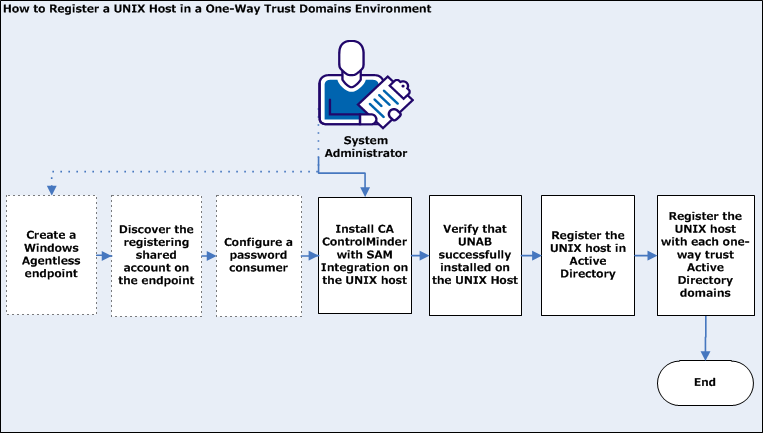

When you register the UNIX host in Active Directory, you use a user account with privileges to retrieve users and groups details from Active Directory. If you register the UNIX host in a two-way trust domains environment, you can use a single user account to retrieve users and groups from every Active Directory domain.
In a one-way trust domain environment the Active Directory account that you use to register a UNIX host cannot retrieve data from other Active Directory domains. In a one way trust domains environment, you register the UNIX host with a regular user account from each Active Directory domain.
Further, you can register a UNIX host with an Active Directory shared account and use SAM to manage the account. The user account must have sufficient permissions to retrieve the user and groups attributes from all every Active Directory domain.
To register a UNIX using a domain account, you use SAM integration. Integrating with SAM enables you to manage the registering user account, for example, apply the domain security policy, change the account password automatically and more.
The following diagram illustrates how to register a UNIX host in a one-way trust domain environment:

Note: Dotted lines indicate optional steps.
Follow these steps:
You specify the connection details of the Active Directory domain that you use to register each UNIX host.
You run the account discovery wizard on the Windows Agentless endpoint that you created.
You specify the UNAB endpoint as an SDK password consumer to enable the endpoint to obtain the registering user account password.
The SAM integration configures the local computer for Shared Accounts Management (SAM). Set the INSTALL_PUPM option to yes to install SAM on the endpoint. For more information about SAM, see the Enterprise Administration Guide.
/opt/CA/AccessControlShared
tcp://ds_dr.comp.com:7222
Note: For more information about the accommon.ini file, see the Reference Guide.
er ACVAR unab value("/opt/CA/uxauth/bin/uxauthd")
er ACVAR unab value+("opt/CA/uxauth/bin/uxconsole")
Note: For more information about the uxconsole utility, see the Reference Guide
|
Copyright © 2013 CA Technologies.
All rights reserved.
|
|